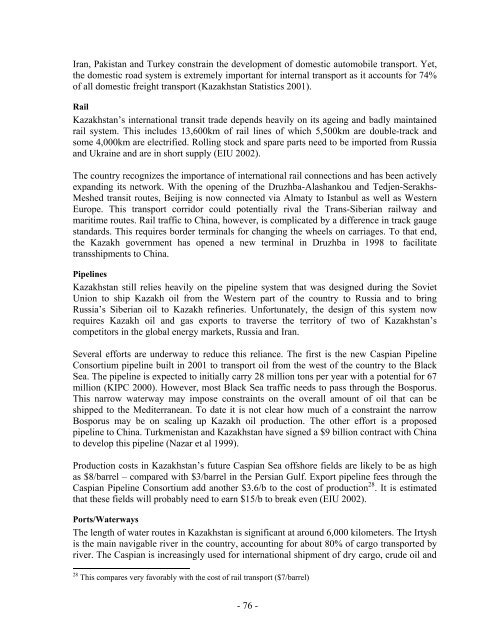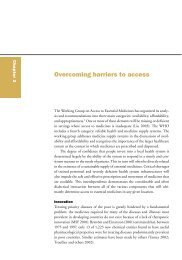the challenges facing landlocked developing countries: a case study ...
the challenges facing landlocked developing countries: a case study ...
the challenges facing landlocked developing countries: a case study ...
You also want an ePaper? Increase the reach of your titles
YUMPU automatically turns print PDFs into web optimized ePapers that Google loves.
Iran, Pakistan and Turkey constrain <strong>the</strong> development of domestic automobile transport. Yet,<br />
<strong>the</strong> domestic road system is extremely important for internal transport as it accounts for 74%<br />
of all domestic freight transport (Kazakhstan Statistics 2001).<br />
Rail<br />
Kazakhstan’s international transit trade depends heavily on its ageing and badly maintained<br />
rail system. This includes 13,600km of rail lines of which 5,500km are double-track and<br />
some 4,000km are electrified. Rolling stock and spare parts need to be imported from Russia<br />
and Ukraine and are in short supply (EIU 2002).<br />
The country recognizes <strong>the</strong> importance of international rail connections and has been actively<br />
expanding its network. With <strong>the</strong> opening of <strong>the</strong> Druzhba-Alashankou and Tedjen-Serakhs-<br />
Meshed transit routes, Beijing is now connected via Almaty to Istanbul as well as Western<br />
Europe. This transport corridor could potentially rival <strong>the</strong> Trans-Siberian railway and<br />
maritime routes. Rail traffic to China, however, is complicated by a difference in track gauge<br />
standards. This requires border terminals for changing <strong>the</strong> wheels on carriages. To that end,<br />
<strong>the</strong> Kazakh government has opened a new terminal in Druzhba in 1998 to facilitate<br />
transshipments to China.<br />
Pipelines<br />
Kazakhstan still relies heavily on <strong>the</strong> pipeline system that was designed during <strong>the</strong> Soviet<br />
Union to ship Kazakh oil from <strong>the</strong> Western part of <strong>the</strong> country to Russia and to bring<br />
Russia’s Siberian oil to Kazakh refineries. Unfortunately, <strong>the</strong> design of this system now<br />
requires Kazakh oil and gas exports to traverse <strong>the</strong> territory of two of Kazakhstan’s<br />
competitors in <strong>the</strong> global energy markets, Russia and Iran.<br />
Several efforts are underway to reduce this reliance. The first is <strong>the</strong> new Caspian Pipeline<br />
Consortium pipeline built in 2001 to transport oil from <strong>the</strong> west of <strong>the</strong> country to <strong>the</strong> Black<br />
Sea. The pipeline is expected to initially carry 28 million tons per year with a potential for 67<br />
million (KIPC 2000). However, most Black Sea traffic needs to pass through <strong>the</strong> Bosporus.<br />
This narrow waterway may impose constraints on <strong>the</strong> overall amount of oil that can be<br />
shipped to <strong>the</strong> Mediterranean. To date it is not clear how much of a constraint <strong>the</strong> narrow<br />
Bosporus may be on scaling up Kazakh oil production. The o<strong>the</strong>r effort is a proposed<br />
pipeline to China. Turkmenistan and Kazakhstan have signed a $9 billion contract with China<br />
to develop this pipeline (Nazar et al 1999).<br />
Production costs in Kazakhstan’s future Caspian Sea offshore fields are likely to be as high<br />
as $8/barrel – compared with $3/barrel in <strong>the</strong> Persian Gulf. Export pipeline fees through <strong>the</strong><br />
Caspian Pipeline Consortium add ano<strong>the</strong>r $3.6/b to <strong>the</strong> cost of production 28 . It is estimated<br />
that <strong>the</strong>se fields will probably need to earn $15/b to break even (EIU 2002).<br />
Ports/Waterways<br />
The length of water routes in Kazakhstan is significant at around 6,000 kilometers. The Irtysh<br />
is <strong>the</strong> main navigable river in <strong>the</strong> country, accounting for about 80% of cargo transported by<br />
river. The Caspian is increasingly used for international shipment of dry cargo, crude oil and<br />
28 This compares very favorably with <strong>the</strong> cost of rail transport ($7/barrel)<br />
- 76 -
















